八下Unit 2 I'll help to clean up the city parks. 单元知识点复习(共34张PPT)
文档属性
| 名称 | 八下Unit 2 I'll help to clean up the city parks. 单元知识点复习(共34张PPT) |  | |
| 格式 | zip | ||
| 文件大小 | 389.2KB | ||
| 资源类型 | 教案 | ||
| 版本资源 | 人教新目标(Go for it)版 | ||
| 科目 | 英语 | ||
| 更新时间 | 2023-04-07 13:59:25 | ||
图片预览


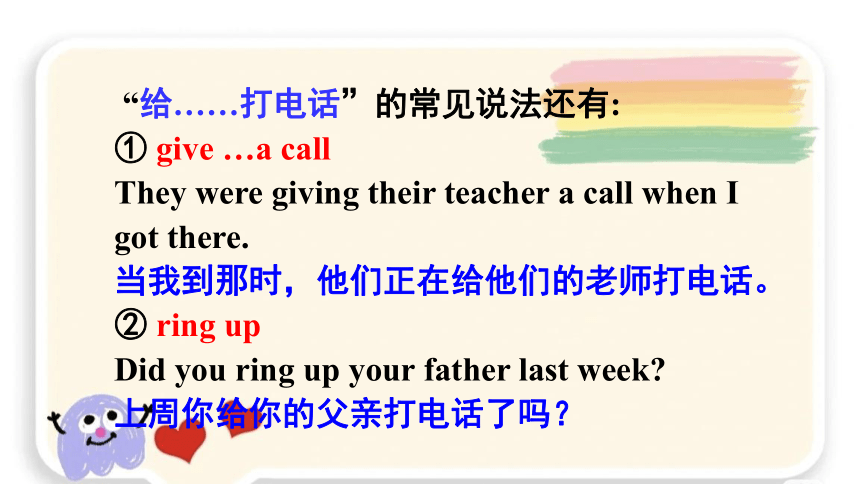
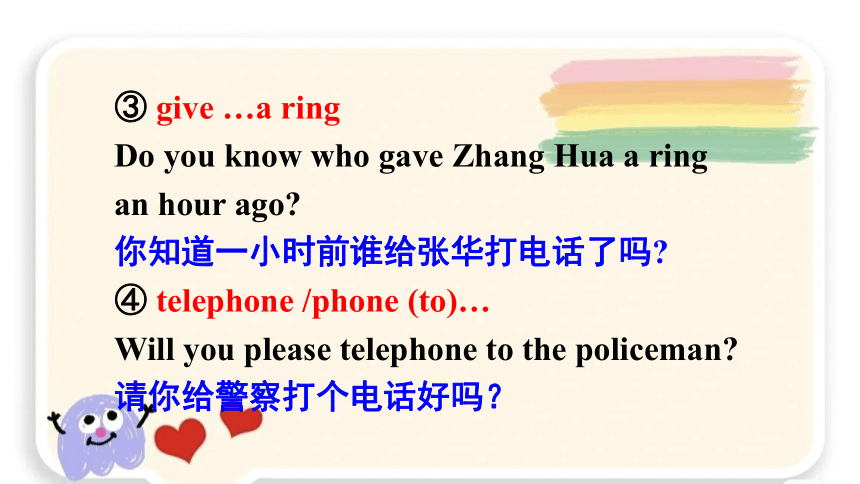
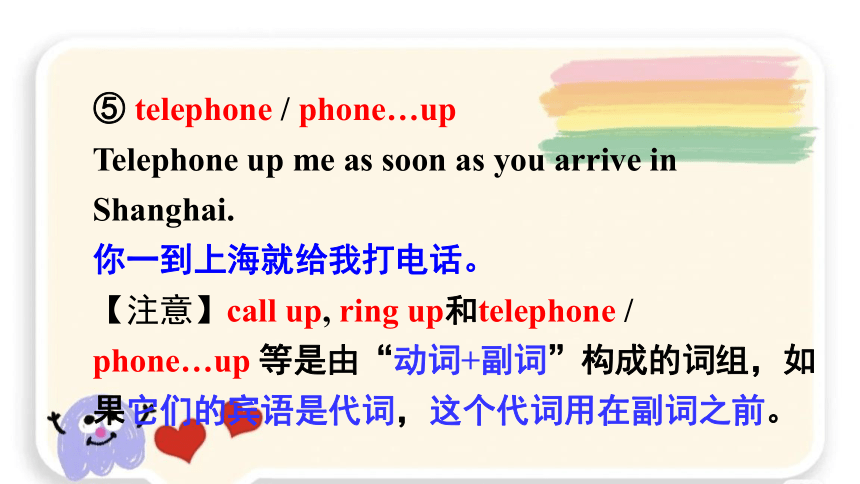

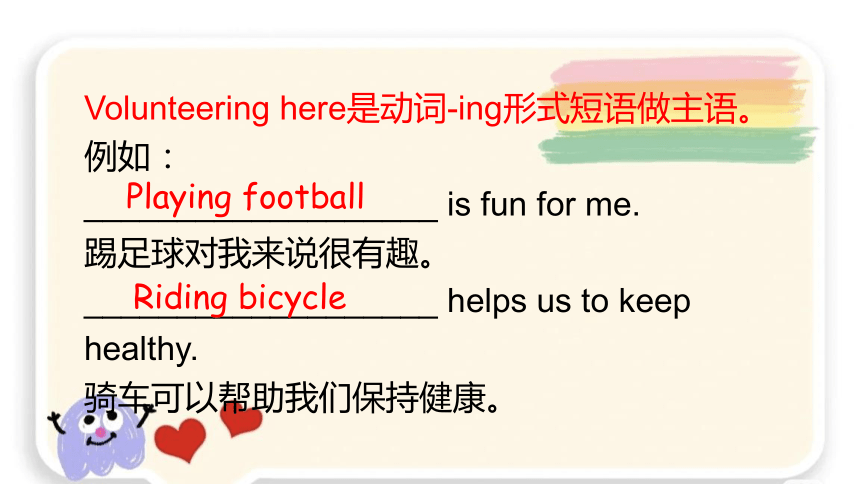
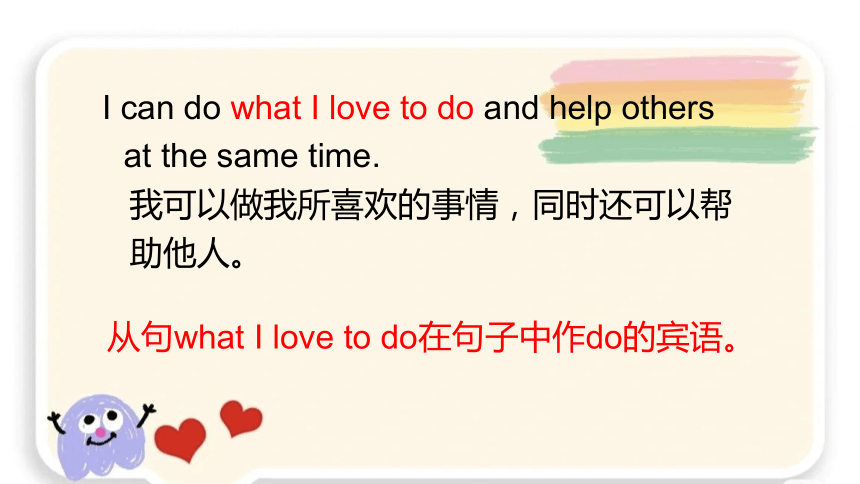
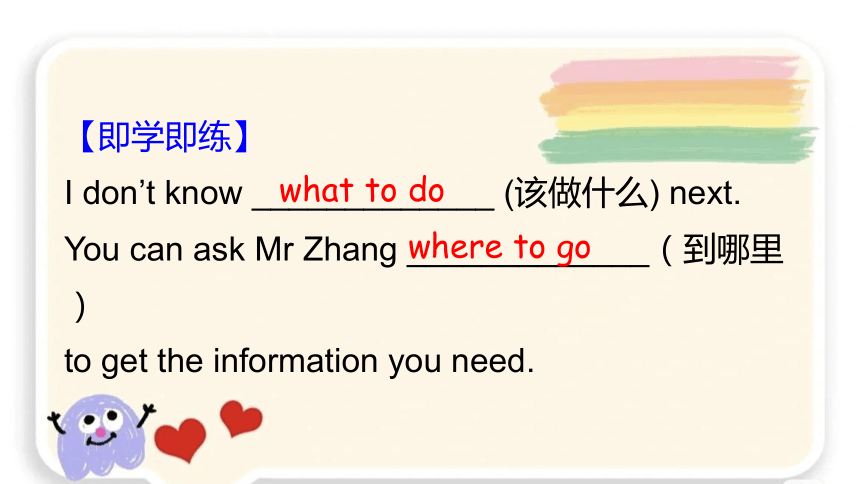
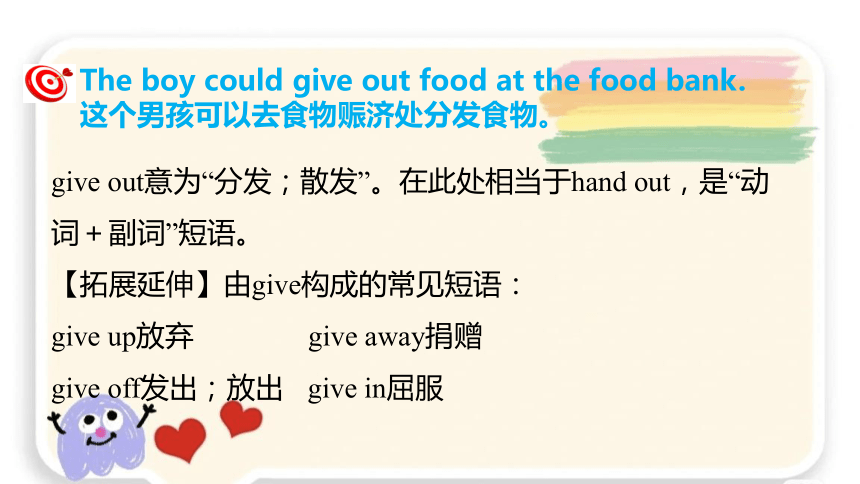

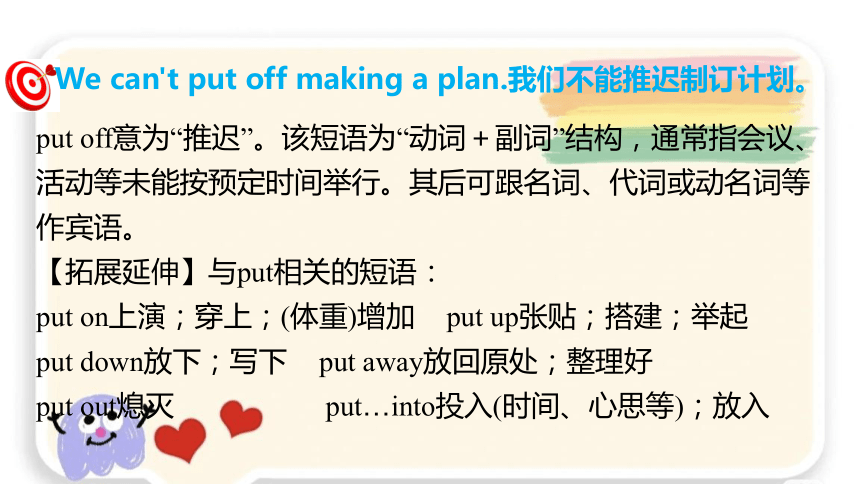
文档简介
(共34张PPT)
Unit 2
I’ll help to clean up the city parks.
知识点复习
....and called up all his friends and told them
about the problem.
给他所有的朋友打电话告诉他们他的问题。
call up 表示“给……打电话”, 后面接指人的词。
这个男孩给你打电话只是为了聊天吗?
Did the boy call you up just for a chat
Language points
“给……打电话”的常见说法还有:
① give …a call
They were giving their teacher a call when I got there.
当我到那时,他们正在给他们的老师打电话。
② ring up
Did you ring up your father last week
上周你给你的父亲打电话了吗?
③ give …a ring
Do you know who gave Zhang Hua a ring an hour ago
你知道一小时前谁给张华打电话了吗
④ telephone /phone (to)…
Will you please telephone to the policeman
请你给警察打个电话好吗?
⑤ telephone / phone…up
Telephone up me as soon as you arrive in Shanghai.
你一到上海就给我打电话。
【注意】call up, ring up和telephone /
phone…up 等是由“动词+副词”构成的词组,如果它们的宾语是代词,这个代词用在副词之前。
Volunteering here is a dream come true for me.
在这里当志愿者对我来说是梦想成真。
此句中a dream come true表示“梦想成为现实;
梦想成真”,是一个常见的表达方式。例如:
I got the latest CD player as a birthday present yesterday. It was just a dream come true.
昨天我收到了一份生日礼物,是那种最新的光碟
播放机,真是梦想成真了!
Volunteering here是动词-ing形式短语做主语。例如:
___________________ is fun for me.
踢足球对我来说很有趣。
___________________ helps us to keep healthy.
骑车可以帮助我们保持健康。
Playing football
Riding bicycle
I can do what I love to do and help others at the same time.
我可以做我所喜欢的事情,同时还可以帮
助他人。
从句what I love to do在句子中作do的宾语。
【即学即练】
I don’t know _____________ (该做什么) next.
You can ask Mr Zhang _____________(到哪里)
to get the information you need.
what to do
where to go
The boy could give out food at the food bank.这个男孩可以去食物赈济处分发食物。
give out意为“分发;散发”。在此处相当于hand out,是“动词+副词”短语。
【拓展延伸】由give构成的常见短语:
give up放弃 give away捐赠
give off发出;放出 give in屈服
We need to come up with a plan to tell people about the city park clean-up.我们需要想出一个计划来告诉人们有关城市公园清洁的事情。
come up with意为“想出;提出(主意、计划等)”,为固定短语,相当于think up。
【同类归纳】“动词+up with”结构的短语:
catch up with赶上;追上
keep up with跟上;紧跟
put up with容忍;忍得住
end up with以……结束
We can't put off making a plan.我们不能推迟制订计划。
put off意为“推迟”。该短语为“动词+副词”结构,通常指会议、活动等未能按预定时间举行。其后可跟名词、代词或动名词等作宾语。
【拓展延伸】与put相关的短语:
put on上演;穿上;(体重)增加 put up张贴;搭建;举起
put down放下;写下 put away放回原处;整理好
put out熄灭 put…into投入(时间、心思等);放入
Yeah,a lot of old people are lonely.是的,许多老人都感到孤独。
【易混辨析】alone与lonely
alone 副词 独自;单独地 常作方式状语,修饰动作,相当于by oneself。
形容词 独自的;单独的 在句中作表语,不含感彩,表示客观状况(强调形体上的)。
lonely 形容词 孤独的;寂寞的 常作表语,也可作定语,强调内心的孤独,带有浓厚的感彩(强调感情上的)。
I get such a strong feeling of satisfaction…我产生出那么一种很强烈的满足感……
such意为“如此;这样”。在此作形容词。修饰单数名词时,放在不定冠词之前;若名词前有one,no,any,some,all等词修饰时,such放在这些词之后。
I never know such a man.我从不认识这样一个人。
There is no such thing.没有这么一回事。
【易混辨析】such与so
such
such+a/an(+形容词)+单数名词 such a(kind) boy
such+形容词+复数名词/不可数名词 such kind boys;such fine weather
so
so +形容词/副词 so good/carefully
so+形容词+a/ an+单数名词 so kind a boy
so+many/much/few/little+名词 so many books;so much work
satisfaction意为“满足;满意”,为不可数名词,其反义词是dissatisfaction。
【拓展延伸】
satisfaction(n.满意)→satisfy(v.使满意)→satisfied(adj.满意的) →satisfying(adj.令人满意的)
【常用搭配】
to one's satisfaction 使/令某人满意/满足
express one's satisfaction at/with 对……表示满意
with satisfaction满意地 satisfy one's needs满足某人的需要
be satisfied with 对……感到满意
be satisfied to do sth.对做某事感到满意
…or raise money for homeless people.……或者为无家可归的人筹钱。
raise作及物动词,意为“筹集;募集”。
raise…for…意为“为……筹集……”。
【拓展延伸】raise的其他用法:
①(同lift)举起;抬起
raise one's hand 举起手
②养育;饲养;种植
raise a family 养家 raise sheep 养羊
③(同 set up)建立;竖起
raise a monument 建立一座纪念碑
④提高;升高
raise one's voice 提高声音
You helped to make it possible for me to have Lucky.有了你的帮助,我才有可能拥有lucky。
make it+adj.+for sb.to do sth.意为“使做某事对某人来说……”,为常用结构,该结构中it作形式宾语,真正的宾语是后面的动词不定式短语。
His advice makes it easy for me to learn English.他的建议使得学英语对我来说简单了。
【拓展延伸】常用于这种结构的动词还有:think,find,believe,feel,consider,suppose等。
I’ve run out of it.
run out of = use up “用完”、“卖光”。句子
的主语是人或使用的物。注意不能用于被动语态。
e.g. I am running out of my money.
= My money is running out.
We are running out of the gas.
= Our car is running out of the gas.
I take after my father.
take after 意为“在外貌、性格等方面与(父
母)相像”。
与take after意思相近的词组还有look like (看
去像……)、be like (像……一样)。
五、单元语法点回顾
短语动词
1.定义:短语动词是由动词加介词、副词或其他词构成的固定词组或习语(idioms),其作用和动词差不多。有些短语动词相当于及物动词,有些则相当于不及物动词。
2.类型及用法:
(1)动词+介词(+sb./sth.),相当于一个及物动词,它的宾语总是在介词之后。
如:look after, look at, listen to, take after等。
e.g.She takes after her father.
(2)动词+副词 既可以充当及物动词也可以充当不及物动词。
常见的动词+副词结构的短语有:put up, hand out, give out, call up, cheer up, put off, look up, turn on/off, get up等。此类短语动词后面接名词时,名词可以放在副词之后,也可以放在副词和动词之间。接代词时,只能放在动词和副词之间。
e.g. take off your coat或take your coat off.
e.g. He looks sad. Let’s cheer him up.
(3)动词+副词+介词,相当于一个及物动词,宾语总是位于介词之后。常见的有:come up with, run out of, look forward to等。
动词不定式
动词不定式是一种非谓语动词形式,在句中不能作谓语,没有人称和数的变化。
基本形式:to+动词原形,有时to可以省略;否定形式:not + 动词不定式。
动词不定式具有名词、形容词和副词的特征,因此可以在句中作主语、宾语、宾语补足语、定语和状语等。
一、 作宾语
动词不定式(短语)可以放在一些动词后面
用作宾语,能以动词不定式作宾语的动词有:
begin, want, remember, agree, learn, like, decide, fail, pretend, demand, refuse等。
例如:
I want to tell you a story.
They begin to work at eight every morning.
Don’t forget to lock the door.
Would you like to go and have a picnic with us tomorrow
二、 作宾语补足语
动词不定式作宾语补足语,表示宾语所做的动作,可以用动词不定式作宾语补足语的动词有:tell, ask, want, like, invite, encourage, help等。如:
The teacher asked us to read English for half an hour in the morning.
The teacher often tells Jim not to spend too much time playing computer games.
Please let me help you.
但在let, make, see, watch, hear, feel, notice, have等感官听觉动词或使役动词后面作宾语补足语的动词, 其不定式一般要省略动词不定式符号“to”,可以归纳为以下三种句式:
1.不可以省略to的不定式作宾语补足语:
tell /ask / want / would like / wish /
suppose / invite /encourage /teach/ depend on等 + sb.+ to do sth.
例如:
The teacher told us to come earlier.
Tom invited me to his birthday party.
Her parents wish her to be a teacher.
2.省“to”的不定式作宾语补足语:
let / make / have + sb. +do sth. 例如:
Let the girl leave here now.
The boy made the baby cry.
see / watch / hear / notice / feel +sb.+do sth.
例如:
I saw the students play basketball on the playground yesterday.
I often hear the girl sing in the next room.
3.可省可不省的: help sb. (to)do sth.
例如:
I often help my mother (to) do housework.
三. 作状语:
(1)作目的状语。强调动词不定式所表示的目的时,动词不定式可用in order to或so as to +动词原形,so as to不用于句首。
例如:
He stopped to have a rest.
The bus stopped so as to pick up passengers.
(2)作结果状语。
例如:
He woke up only to find everybody gone.
His grandma lived to see the liberation of China.
He is old enough to go to school.
(3)在某些表示喜、怒、哀、乐等的形容词后作原因状语。例如:
I’m proud to have taken part in the competitions ...
I’m happy to have found many things
I can do.
(1)动词不定式的否定式是直接在to之前加not. 如:
Tell them not to play football in the street.
(2)省略to的动词不定式的否定式是直接在动词前面加not. 如:
Let the boy not go.
动词不定式的否定形式:
Unit 2
I’ll help to clean up the city parks.
知识点复习
....and called up all his friends and told them
about the problem.
给他所有的朋友打电话告诉他们他的问题。
call up 表示“给……打电话”, 后面接指人的词。
这个男孩给你打电话只是为了聊天吗?
Did the boy call you up just for a chat
Language points
“给……打电话”的常见说法还有:
① give …a call
They were giving their teacher a call when I got there.
当我到那时,他们正在给他们的老师打电话。
② ring up
Did you ring up your father last week
上周你给你的父亲打电话了吗?
③ give …a ring
Do you know who gave Zhang Hua a ring an hour ago
你知道一小时前谁给张华打电话了吗
④ telephone /phone (to)…
Will you please telephone to the policeman
请你给警察打个电话好吗?
⑤ telephone / phone…up
Telephone up me as soon as you arrive in Shanghai.
你一到上海就给我打电话。
【注意】call up, ring up和telephone /
phone…up 等是由“动词+副词”构成的词组,如果它们的宾语是代词,这个代词用在副词之前。
Volunteering here is a dream come true for me.
在这里当志愿者对我来说是梦想成真。
此句中a dream come true表示“梦想成为现实;
梦想成真”,是一个常见的表达方式。例如:
I got the latest CD player as a birthday present yesterday. It was just a dream come true.
昨天我收到了一份生日礼物,是那种最新的光碟
播放机,真是梦想成真了!
Volunteering here是动词-ing形式短语做主语。例如:
___________________ is fun for me.
踢足球对我来说很有趣。
___________________ helps us to keep healthy.
骑车可以帮助我们保持健康。
Playing football
Riding bicycle
I can do what I love to do and help others at the same time.
我可以做我所喜欢的事情,同时还可以帮
助他人。
从句what I love to do在句子中作do的宾语。
【即学即练】
I don’t know _____________ (该做什么) next.
You can ask Mr Zhang _____________(到哪里)
to get the information you need.
what to do
where to go
The boy could give out food at the food bank.这个男孩可以去食物赈济处分发食物。
give out意为“分发;散发”。在此处相当于hand out,是“动词+副词”短语。
【拓展延伸】由give构成的常见短语:
give up放弃 give away捐赠
give off发出;放出 give in屈服
We need to come up with a plan to tell people about the city park clean-up.我们需要想出一个计划来告诉人们有关城市公园清洁的事情。
come up with意为“想出;提出(主意、计划等)”,为固定短语,相当于think up。
【同类归纳】“动词+up with”结构的短语:
catch up with赶上;追上
keep up with跟上;紧跟
put up with容忍;忍得住
end up with以……结束
We can't put off making a plan.我们不能推迟制订计划。
put off意为“推迟”。该短语为“动词+副词”结构,通常指会议、活动等未能按预定时间举行。其后可跟名词、代词或动名词等作宾语。
【拓展延伸】与put相关的短语:
put on上演;穿上;(体重)增加 put up张贴;搭建;举起
put down放下;写下 put away放回原处;整理好
put out熄灭 put…into投入(时间、心思等);放入
Yeah,a lot of old people are lonely.是的,许多老人都感到孤独。
【易混辨析】alone与lonely
alone 副词 独自;单独地 常作方式状语,修饰动作,相当于by oneself。
形容词 独自的;单独的 在句中作表语,不含感彩,表示客观状况(强调形体上的)。
lonely 形容词 孤独的;寂寞的 常作表语,也可作定语,强调内心的孤独,带有浓厚的感彩(强调感情上的)。
I get such a strong feeling of satisfaction…我产生出那么一种很强烈的满足感……
such意为“如此;这样”。在此作形容词。修饰单数名词时,放在不定冠词之前;若名词前有one,no,any,some,all等词修饰时,such放在这些词之后。
I never know such a man.我从不认识这样一个人。
There is no such thing.没有这么一回事。
【易混辨析】such与so
such
such+a/an(+形容词)+单数名词 such a(kind) boy
such+形容词+复数名词/不可数名词 such kind boys;such fine weather
so
so +形容词/副词 so good/carefully
so+形容词+a/ an+单数名词 so kind a boy
so+many/much/few/little+名词 so many books;so much work
satisfaction意为“满足;满意”,为不可数名词,其反义词是dissatisfaction。
【拓展延伸】
satisfaction(n.满意)→satisfy(v.使满意)→satisfied(adj.满意的) →satisfying(adj.令人满意的)
【常用搭配】
to one's satisfaction 使/令某人满意/满足
express one's satisfaction at/with 对……表示满意
with satisfaction满意地 satisfy one's needs满足某人的需要
be satisfied with 对……感到满意
be satisfied to do sth.对做某事感到满意
…or raise money for homeless people.……或者为无家可归的人筹钱。
raise作及物动词,意为“筹集;募集”。
raise…for…意为“为……筹集……”。
【拓展延伸】raise的其他用法:
①(同lift)举起;抬起
raise one's hand 举起手
②养育;饲养;种植
raise a family 养家 raise sheep 养羊
③(同 set up)建立;竖起
raise a monument 建立一座纪念碑
④提高;升高
raise one's voice 提高声音
You helped to make it possible for me to have Lucky.有了你的帮助,我才有可能拥有lucky。
make it+adj.+for sb.to do sth.意为“使做某事对某人来说……”,为常用结构,该结构中it作形式宾语,真正的宾语是后面的动词不定式短语。
His advice makes it easy for me to learn English.他的建议使得学英语对我来说简单了。
【拓展延伸】常用于这种结构的动词还有:think,find,believe,feel,consider,suppose等。
I’ve run out of it.
run out of = use up “用完”、“卖光”。句子
的主语是人或使用的物。注意不能用于被动语态。
e.g. I am running out of my money.
= My money is running out.
We are running out of the gas.
= Our car is running out of the gas.
I take after my father.
take after 意为“在外貌、性格等方面与(父
母)相像”。
与take after意思相近的词组还有look like (看
去像……)、be like (像……一样)。
五、单元语法点回顾
短语动词
1.定义:短语动词是由动词加介词、副词或其他词构成的固定词组或习语(idioms),其作用和动词差不多。有些短语动词相当于及物动词,有些则相当于不及物动词。
2.类型及用法:
(1)动词+介词(+sb./sth.),相当于一个及物动词,它的宾语总是在介词之后。
如:look after, look at, listen to, take after等。
e.g.She takes after her father.
(2)动词+副词 既可以充当及物动词也可以充当不及物动词。
常见的动词+副词结构的短语有:put up, hand out, give out, call up, cheer up, put off, look up, turn on/off, get up等。此类短语动词后面接名词时,名词可以放在副词之后,也可以放在副词和动词之间。接代词时,只能放在动词和副词之间。
e.g. take off your coat或take your coat off.
e.g. He looks sad. Let’s cheer him up.
(3)动词+副词+介词,相当于一个及物动词,宾语总是位于介词之后。常见的有:come up with, run out of, look forward to等。
动词不定式
动词不定式是一种非谓语动词形式,在句中不能作谓语,没有人称和数的变化。
基本形式:to+动词原形,有时to可以省略;否定形式:not + 动词不定式。
动词不定式具有名词、形容词和副词的特征,因此可以在句中作主语、宾语、宾语补足语、定语和状语等。
一、 作宾语
动词不定式(短语)可以放在一些动词后面
用作宾语,能以动词不定式作宾语的动词有:
begin, want, remember, agree, learn, like, decide, fail, pretend, demand, refuse等。
例如:
I want to tell you a story.
They begin to work at eight every morning.
Don’t forget to lock the door.
Would you like to go and have a picnic with us tomorrow
二、 作宾语补足语
动词不定式作宾语补足语,表示宾语所做的动作,可以用动词不定式作宾语补足语的动词有:tell, ask, want, like, invite, encourage, help等。如:
The teacher asked us to read English for half an hour in the morning.
The teacher often tells Jim not to spend too much time playing computer games.
Please let me help you.
但在let, make, see, watch, hear, feel, notice, have等感官听觉动词或使役动词后面作宾语补足语的动词, 其不定式一般要省略动词不定式符号“to”,可以归纳为以下三种句式:
1.不可以省略to的不定式作宾语补足语:
tell /ask / want / would like / wish /
suppose / invite /encourage /teach/ depend on等 + sb.+ to do sth.
例如:
The teacher told us to come earlier.
Tom invited me to his birthday party.
Her parents wish her to be a teacher.
2.省“to”的不定式作宾语补足语:
let / make / have + sb. +do sth. 例如:
Let the girl leave here now.
The boy made the baby cry.
see / watch / hear / notice / feel +sb.+do sth.
例如:
I saw the students play basketball on the playground yesterday.
I often hear the girl sing in the next room.
3.可省可不省的: help sb. (to)do sth.
例如:
I often help my mother (to) do housework.
三. 作状语:
(1)作目的状语。强调动词不定式所表示的目的时,动词不定式可用in order to或so as to +动词原形,so as to不用于句首。
例如:
He stopped to have a rest.
The bus stopped so as to pick up passengers.
(2)作结果状语。
例如:
He woke up only to find everybody gone.
His grandma lived to see the liberation of China.
He is old enough to go to school.
(3)在某些表示喜、怒、哀、乐等的形容词后作原因状语。例如:
I’m proud to have taken part in the competitions ...
I’m happy to have found many things
I can do.
(1)动词不定式的否定式是直接在to之前加not. 如:
Tell them not to play football in the street.
(2)省略to的动词不定式的否定式是直接在动词前面加not. 如:
Let the boy not go.
动词不定式的否定形式:
同课章节目录
- Unit 1 What's the matter?
- Section A
- Section B
- Unit 2 I'll help to clean up the city parks.
- Section A
- Section B
- Unit 3 Could you please clean your room?
- Section A
- Section B
- Unit 4 Why don't you talk to your parents?
- Section A
- Section B
- Unit 5 What were you doing when the rainstorm came
- Section A
- Section B
- Review of Units 1-5
- Unit 6 An old man tried to move the mountains.
- Section A
- Section B
- Unit 7 What's the highest mountain in the world?
- Section A
- Section B
- Unit 8 Have you read Treasure Island yet?
- Section A
- Section B
- Unit 9 Have you ever been to a museum?
- Section A
- Section B
- Unit 10 I've had this bike for three years.
- Section A
- Section B
